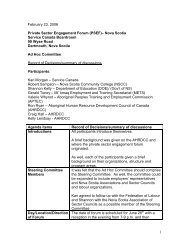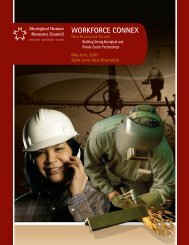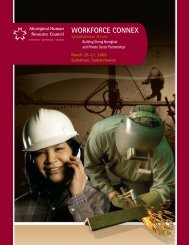Workforce connex - Aboriginal Human Resource Council
Workforce connex - Aboriginal Human Resource Council
Workforce connex - Aboriginal Human Resource Council
You also want an ePaper? Increase the reach of your titles
YUMPU automatically turns print PDFs into web optimized ePapers that Google loves.
•Different points of entry.• Knowledge of jobs (i.e., job postings, switch from mainstreammedia, NCI, community access channels).• Job descriptors (i.e., entry level is entry level; what employer wantsand what the person needs – mismatched expectations).• Smook Bros. – offers holistic environment to <strong>Aboriginal</strong>hires; offers housing and transportation etc.• War Lake – tender documents for work, incorporate localhires into tender documents. Needs to be more within tenderdocuments to hire <strong>Aboriginal</strong> people (nursing station built).•First People – Quarterly meetings – invite employers to meeting.• Maple Leaf (in Brandon) – provide transportationto hires; try to provide housing to people.••Camp environment to <strong>Aboriginal</strong> people but faced resistance (tried to set up).People move to Alberta because incentive of housing provided.• Memoranda of Understanding (MOUs) – controversyof how many people to hire.• Partnerships – no cap on how many people willhire; being clear on qualifications helps.• Transitioning careers – training ending at a certainage, everything geared towards youth.• Burntwood – older employee; position became obsolete; hadeverything but lacked in skills; had a great attitude; partneredwith MMF and enrolled in Power Engineer course.• Innovation needed – found a way to re-train individual; easierto re-train regular employee already established with thecompany than an outside individual – difficult to transition.••••Hard to work with person who is already employed; to sell idea.More success if was not solely geared towards <strong>Aboriginal</strong> youth.Tender documents – housing.Leadership that micromanages.• Staff works hard, makes connections butleadership / political “slows process”.• AHRDAs need to prepare people for workplace; agreementsdo not reflect this intense work with individual. Most timespent with individual not creating partnership.•••Colleges need to connect with employers – some make good connections.Urban circle has an “employer” outreach community.Supply side groups are strained with many roles – not enough time.• Understanding what investment the employer is ready tomake in a candidate and in building understanding.•Employers want (strongest) applicant; employers should look at a••person’s potential and have the capacity to develop that potential.What is an AHRDA using to assess a candidate?Need to examine and advocate for changes in criminal records.• Leadership to look at (regionalizing) training programs– so trainees stay in their geographic area.• AHRDA need to know how and who to approach – especially smallcommunities who do not have dollars to send students to where training is.• Employers not in geographic location – membersleave to train and then work.• There are “trained” people on reserve – but “certification”is not available; they have been qualifying for years.•••Opportunities are “limited” for employers to set up business on reserve.Need a list of employers of choice.Time, time, time, lots of outreach required (special outreach talent).• Barrier for AHRDAs’ clients and employers understanding the“criminal record” – what it really means, what guidelinesto use, how to get a pardon – costs of pardon etc.•••Employers learn how to set up business on reserve.Employees move on to other provinces.Fear of First Nation protocols (chief and council).• Need to know and engage proper authorities in the community– employment office, Economic Development Officers, etc.• Only use AHRDA to source for quotas – do not takethem seriously if the “quota” has been met.•••••••••••••••Required vs. requested vs. acceptable.Intimidating screening and interview process.Lack of buy in; fear of failure.Competitiveness between AHRDA – lack of cooperation.Corporate inclusiveness culture does not filter down to work environment.Lack of will to provide transitional program help.Assumption of skill set – internet usage, divers license.HR turnover frustrations.Job postings have quick deadlines.Utilization of AHRDA is sporadic.Lack of employment on First Nation communities.Don’t appreciate the labour market challenges – denial.Afraid of preference hiring affirmative action etc.Underlying prejudices, fear of stereotypes.Competition against skilled immigrants – no training needed.• Attitude of accessing foreign labor.<strong>Aboriginal</strong> <strong>Human</strong> <strong>Resource</strong> <strong>Council</strong> Manitoba <strong>Workforce</strong> Connex Report 19









